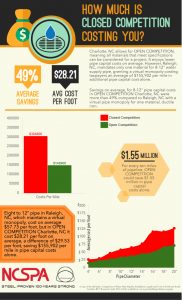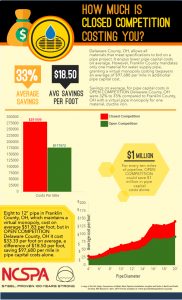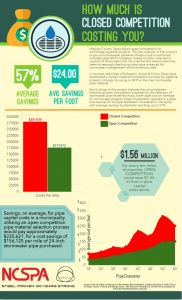Competition saves money
This is a self-evident truth of our capitalistic democracy.
When open competition is allowed on construction projects the material costs for public projects can drop dramatically. With the savings not coming from the use of lesser performing materials, but instead resulting from lower bid costs. Make no mistake the performance requirements of the materials must continue to be maintained. And justifications can be made through engineering evaluations or economic analysis requiring the use of a particular material. However, when multiple materials meet the criteria, as is the case in the majority of projects, they all should be bid.
Open Competition Among Federally-Funded Public Works Projects
What does that mean?
A Brief History Of Anti-Competition Regulations:
Remaining unchanged since 1976, 23 CFR 635.411 provided the regulations that governed the type of culvert and storm sewer materials selected for federal construction projects. In 2005, SAFETEA-LU (Section 5514) introduced legislative language that removed the old requirements from 1976. This created an environment of fair and open competition at the state level for all culvert manufacturers.
In 2012 the Moving Ahead for Progress in the 21st Century Act (MAP-21) bill was signed into law. Contained within the new law was an outdated provision that created an unfair void in the contracting terms on federally funded transportation projects. The provision, quietly added by a special interest group, restricted the choices in materials for culvert and storm sewer projects. This restriction has resulted in hundreds of millions of dollars of unnecessary overspending by federal, state and local governments.
How does open competition effect infrastructure projects?
The archaic provision within the MAP-21 allows states to select the materials used in theirculvert and storm sewer systems without federal oversight of federal funds This addition to the law has cost the taxpayers hundreds millions of dollars in unnecessary overspending on federal and state transportation projects simply because they are unable to price any alternatives. Allowing for all types of materials to be quoted and used would save tens of millions of dollars a year. Just think of how far those additional funds could go in fixing our countries aging infrastructure!
The NCSPA, along with P.I.P.E. (Partnership for Infrastructure Project Excellence), is committed to fighting this anticompetition policy to ensure that each taxpayer gets the most value out of their dollar. We believe that achieving the best project outcome depends on open and fair competition, and we are working hard to restore needed fairness to our infrastructure contracting process.
FAQs
What Can You Do To Help?
-What can the general public do to help?
-Would an online petition help at all? Like from petitions.whitehouse.gov or change.org?
Resources
Government Documents
Studies
Infographs


